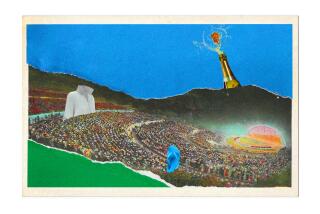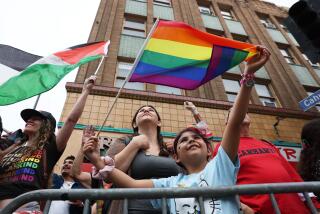March of the Monks : Buddhism: Members of Wat Thai temple make weekly procession in North Hollywood. Ancient ritual is meant to help rid them of earthly desire.
Walking single file, the line of Thai monks slips unnoticed through a residential section of North Hollywood each Saturday at sunup.
They move deliberately, their sandals flapping softly against the sidewalk. Sooner or later, their billowing orange robes betray their presence.
A dog barks. Sleepy-eyed motorists stare.
“I don’t know where they go,” said Richard Holmquist, who paused in his driveway while tying a bag of garbage to watch the procession. “They come by every week. I call them the Orange Brigade.”
Although it is an oddity to neighbors, the march of the monks is an ancient ritual meant to help rid them of earthly desire, a first step on the path to Buddhist enlightenment.
The route takes them from the Wat Thai temple to the front yards of about a dozen Thai American families. There, the monks are offered fruit, rice, bags of curried meat and bottles of water from small tables or the hoods of cars.
In Thailand, where most of the population is Buddhist, providing food for monks has been practiced every morning for centuries, and is not considered charity. By feeding monks, adherents help their mentors become free of material needs, which in turn enhances their own spirituality.
“Hello, Phra Setthakic,” Nith Duangkam, 77, said in Thai, bowing nearly double as she scooped rice into his bowl. “I’m sorry, I cannot come to the temple tomorrow.”
“That’s too bad,” Setthakic said. “I hope you can come soon.”
In Los Angeles, which has the largest Thai community outside Thailand, the alms walk is largely symbolic. The monks say it helps them and their followers remember who they are in the concrete sprawl.
Outside another home, Phra Anon poked his wooden bowl through his robe to accept a neatly wrapped bundle of skewered meat and a box of chocolate milk from a woman bent respectfully low.
Later, Anon confided, “I like chocolate milk.” But, perhaps sensing a transgression, he quickly added: “I like all food the same.”
Thai monks try to rid themselves of desire, and the achievement is their source of holiness. They succeed to varying degrees, depending partly on how long they have been monks.
Anon, 57, quit his computer data entry job three months ago to spend five months as a monk at Wat Thai before he begins another job in Hawaii. For Thai men, joining a temple for at least a few months of their lives is considered crucial to the understanding of Buddha’s teachings.
“My life has been about getting things,” Anon said. “I am learning that money is not so important. Maybe when I go back I won’t be so attached to it.”
Back at the temple, the rice, curries, bananas, grapes and other foods are prepared by volunteers for the 20 monks who live at Wat Thai--the largest Thai temple in the United States. But the supplies will last only a day. The rest of the week, a cook hired by temple supporters prepares food for the monks, who, according to the teachings of Buddha, are forbidden to handle money.
More than 17,000 Thais live in Los Angeles County, according to 1990 census figures, with six temples to serve them.
Phra Sumana, head monk at Wat Thai, said thousands visit the temple each month to ask advice from the monks, pray or study the Thai language, flower arranging and dance.
The monks usually stay within the two-acre temple, where they chant in groups in the morning and evening, meditate alone during the day and perform chores such as sweeping and decorating.
A strict interpretation of the Buddha’s teachings allows them only eight possessions: two robes and an undergarment (all saffron colored), a bowl for accepting food, a razor for keeping the head and face shaved, a sewing needle, orange thread and a cloth water filter.
“We don’t need anything more,” said Phra Setthakic, a 30-year monk, demonstrating how one robe is used for a pillow while the other serves as a blanket. “We can sleep on the ground if we need to.”
A few other trappings, such as eyeglasses, sandals and socks, have made their way onto the unofficial possessions list. Living in Los Angeles, too, has forced the monks to abandon a few taboos. Sumana admits to having been forced several times to drive himself to a grocery store because no help was available.
“A monk in a store does not look right,” Sumana said. “But we have to adjust.”
As have the neighbors of the temple.
Certainly, the sight of the robed monks jaywalking across Coldwater Canyon Avenue is as bizarre as that of their ornate temple flanked by a Mobil station and a tract of stucco homes.
A block west of Wat Thai is Grace Community Church of the Valley.
“They look like they’re out for Halloween,” Rod Smith, security guard and member of the church, said as he watched them pass. “I pity them. I believe they are lost.”
Others see it differently.
“They are part of the community,” said Vytautas Barkus, who walks his dogs near the temple. “They are very peaceful. They cheer me up.”
More to Read
Sign up for Essential California
The most important California stories and recommendations in your inbox every morning.
You may occasionally receive promotional content from the Los Angeles Times.










